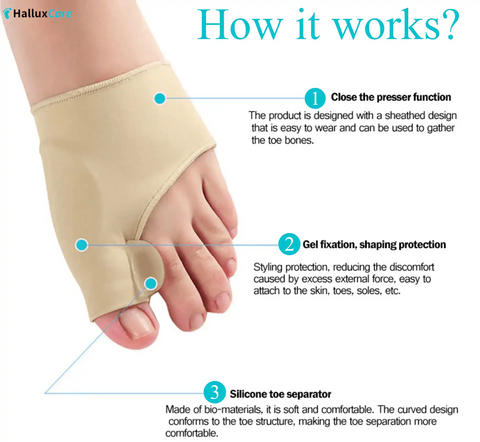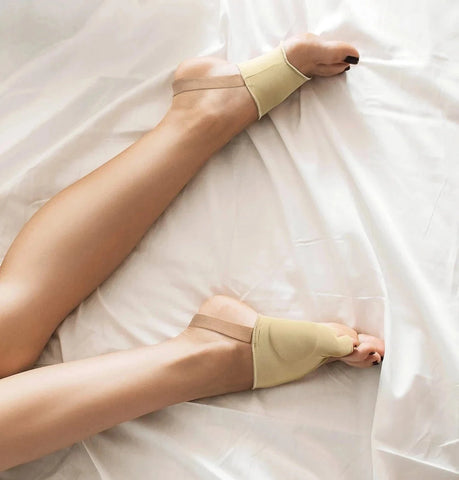Bunions and Bone Surgery: Is Pain Relief More Important Than Appearance?
If you’re researching bunion pain relief and considering whether bunion surgery is worth it, you’re not alone. Many people face a difficult decision—addressing persistent bunion pain or living with the deformity. A recent Reddit comment in the /r/bunions community highlights this: one user explained that they chose bone-cutting surgery not for cosmetic reasons, but because pain from their bunion and bone spurs became unbearable. This candid perspective echoes findings from leading medical sources: pain relief, rather than appearance, is the primary motivation for seeking bunion correction.[1][2]
Key Takeaways
- Pain is the main reason for bunion surgery; appearance is usually secondary.[1]
- Non-surgical methods are often effective for mild to moderate bunions and may delay or prevent surgery.
- Proper footwear and orthopedic sleeves can significantly reduce daily bunion discomfort.
- Consultation with a podiatrist is essential before making decisions about surgery or treatment.
- Surgery is considered when pain disrupts daily life or conservative treatments fail.
Why Do People Really Get Bunion Surgery?
Expert and Medical Perspective
According to the American Academy of Orthopaedic Surgeons (AAOS), most patients seek bunion surgery due to chronic pain and functional limitations—not for cosmetic reasons.[1] Dr. Elizabeth Cody, foot and ankle specialist at the Hospital for Special Surgery, concurs: “Bunion surgery is typically indicated when pain interferes with daily activities and non-surgical treatments are no longer effective.”[2]
Key Takeaways from Real Experiences
- Pain is the Primary Driver: Most people consider bunion surgery only when pain severely impacts their daily life, not just because of how their feet look.
- Function Over Fashion: Those who love walking, hiking, or running often wear sneakers or trainers, so the appearance of their feet is less of a concern.
- Deformity Is Secondary: While correcting the bunion deformity is a bonus, it rarely outweighs the need for pain relief.
4.9 ⭐⭐⭐⭐⭐ ( 1843 reviews)
The Reality of Living with Bunions
Living with a bunion is much more than a visible lump on your foot. From a medical standpoint, bunions (hallux valgus) often result in:
- Chronic pain, especially while walking[1]
- Difficulty finding comfortable shoes
- Bone spurs that exacerbate discomfort
- Limited mobility and daily activity challenges[2]
Surgery is a significant step, and most experts recommend exhausting non-surgical interventions before considering it—especially if your main concern is pain and not appearance.[1][3]
Non-Surgical Bunion Pain Relief Options
1. Orthopedic Bunion Sleeves
- Provide gentle support and realignment
- Reduce friction and pressure inside shoes
- Alleviate daily pain and may slow bunion progression[4]
Practical Tip: Wear sleeves daily, especially during long periods on your feet or exercise.
2. Footwear Adjustments
- Choose wide, supportive shoes with a roomy toe box[1]
- Avoid high heels and pointed shoes
- Use custom orthotics for extra support as recommended by a podiatrist
3. Pain Management Techniques
- Apply ice packs to reduce swelling after activity
- Take over-the-counter NSAIDs (like ibuprofen) as advised by your physician[3]
- Engage in toe stretches and foot-strengthening exercises
4. Protective Padding
- Use bunion pads or cushions to reduce pressure and irritation
Practical Tip: Combine pads with proper footwear for maximum comfort
When Is Bunion Surgery Worth It?
Medical Criteria for Surgery
The AAOS and the American College of Foot and Ankle Surgeons (ACFAS) agree:[1][3]
- Surgery is indicated when pain disrupts daily activities or sleep
- Non-surgical treatments have been exhausted
- The bunion causes recurrent sores, infections, or impacts mobility
Risks of surgery include infection, nerve injury, recurrence, and lengthy recovery periods—so the decision should be carefully considered with your healthcare provider.
Top Factors to Weigh Before Surgery
- Severity of pain and mobility loss
- Impact on quality of life
- Risks and recovery time
- Desire for cosmetic improvement (if applicable)
Bunion Pain Relief That Works
If you’re seeking immediate relief or want to delay surgery, orthopedic bunion sleeves offer a safe, non-invasive option. These medical-grade sleeves are designed to:
- Realign your big toe and relieve pressure
- Reduce pain during daily activities
- Fit comfortably in most shoes
Prevention and early intervention are key: the sooner you address bunion pain, the more likely you are to prevent progression and avoid surgery.
Practical Tips & Real-World Applications
- Track your symptoms: Use a daily log to monitor pain, swelling, and activity levels.
- Rotate shoes: Alternate between supportive pairs to reduce pressure points.
- Consult a podiatrist: Early professional advice can help tailor a treatment plan and prevent further complications.
- Stay active: Low-impact exercises like swimming or cycling can keep you fit without irritating your bunion.
Frequently Asked Questions (FAQs)
Q: Are bunion sleeves effective for severe bunions?
A: Bunion sleeves can provide symptom relief for mild to moderate bunions. For severe deformities, they may help with comfort but won’t reverse the bunion.
Q: Will bunion surgery fix the appearance of my foot?
A: Surgery can correct the alignment of your big toe and improve appearance, but the main goal is to relieve pain and restore function.[1]
Q: How long does it take to recover from bunion surgery?
A: Recovery can take 6–12 weeks, with some patients resuming normal activities after three months. Full healing may take up to six months.[3]
Q: Can bunions come back after surgery?
A: Yes, recurrence is possible, especially if underlying causes (like footwear or genetics) are not addressed.[3]
Q: What are the risks of delaying surgery?
A: Bunions may worsen over time, leading to increased pain, deformity, and joint damage. Early intervention with conservative care is recommended.[1][3]
Let’s Discuss: What Matters Most to You?
Have you struggled with bunion pain? Would you ever consider surgery for cosmetic reasons, or is pain relief your main priority? Share your thoughts and experiences in the comments below—your story could help someone else make an informed decision.
HalluxCare Bunion Relief Products
If you're looking for relief from bunion pain, consider using the Orthopedic Bunion Pain Relief & Correction Sleeve, which provides support and helps to alleviate discomfort.
For additional protection, the Tailor's Bunion Bunionette Pain Relief Protection Sleeves are designed to offer comfort and protection for bunionette pain.
To nourish and soothe the skin around bunions, as well as to promote healthy hair, consider the Jamaica Black Castor Oil Soothing Oil. Known for its moisturizing and anti-inflammatory properties, it helps alleviate discomfort around bunions and supports hair growth and scalp health.
Ready to take the next step in bunion pain relief? Explore these options and let us know which solutions have worked for you!
References
- American Academy of Orthopaedic Surgeons: Bunions (Hallux Valgus)
- Hospital for Special Surgery: Bunion Surgery—What You Need to Know
- American College of Foot and Ankle Surgeons: Bunion Surgery
- Mayo Clinic: Bunion Treatment & Self-care
Dr. Casey Martin, DPM
Board-Certified Podiatric Physician & Surgeon
Member, American Podiatric Medical Association




